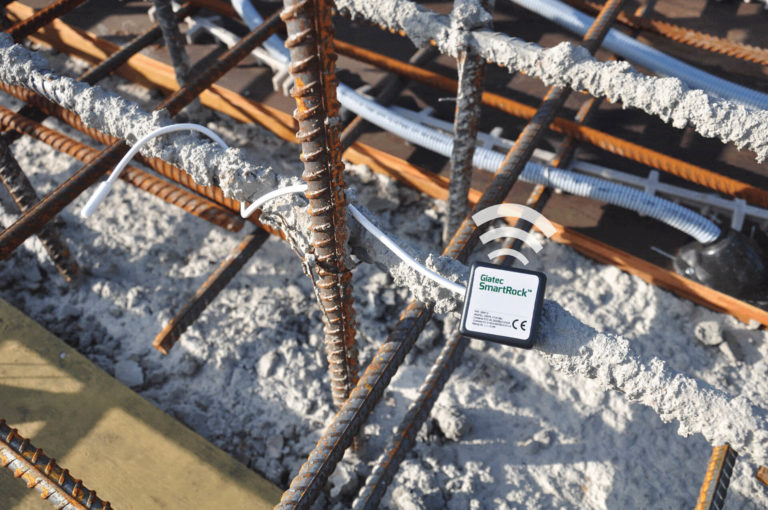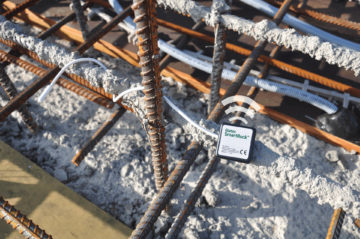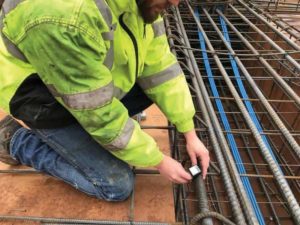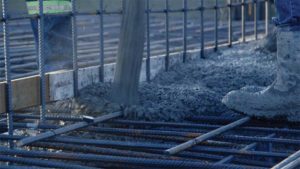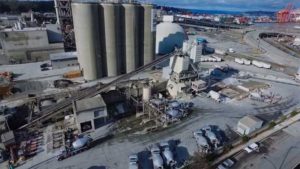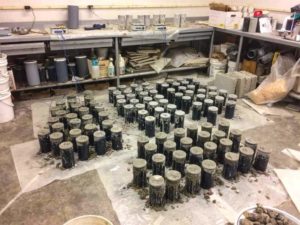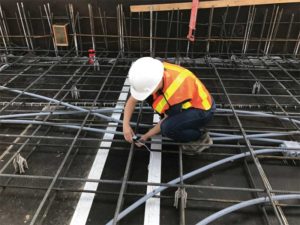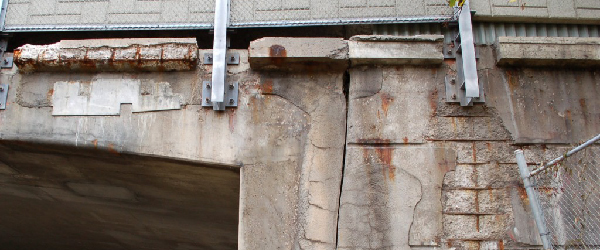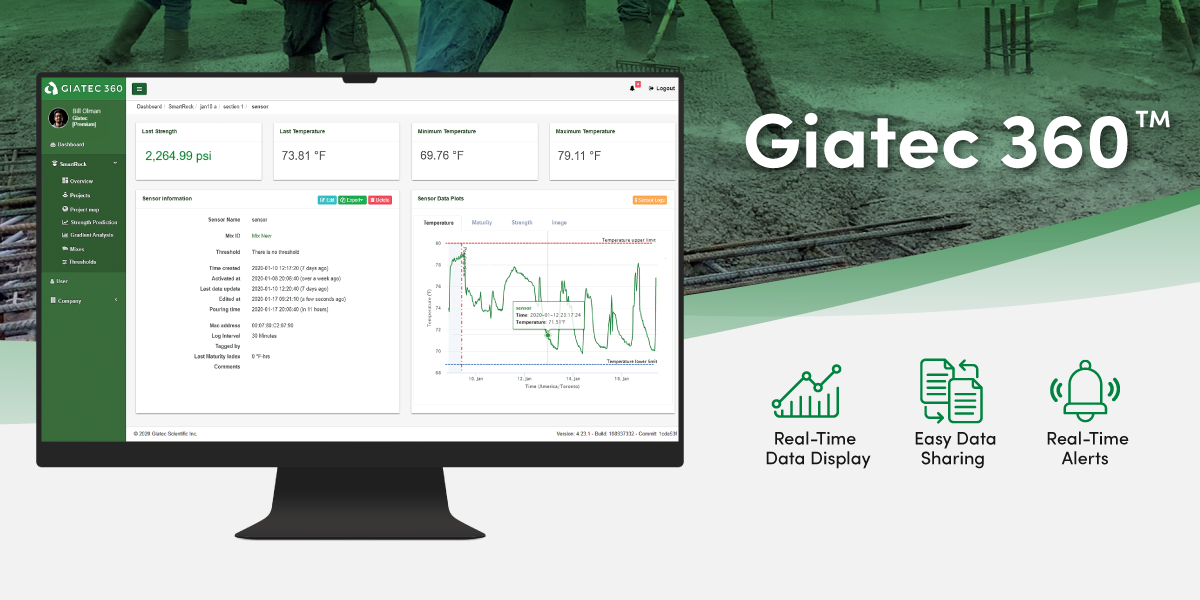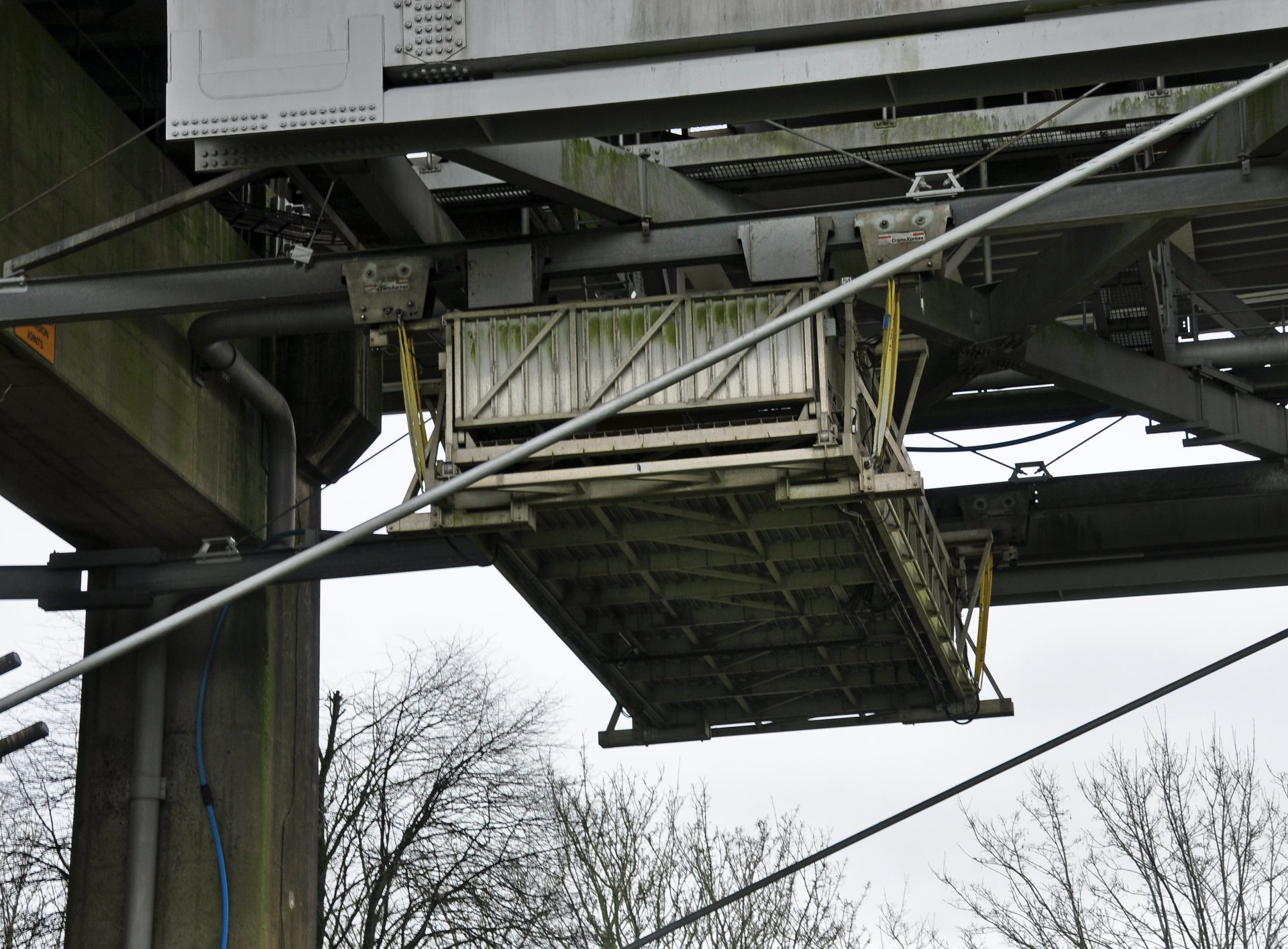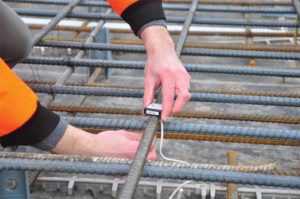

Testing concrete’s strength is essential, but is also messy and expensive. One needs to create test cylinders, cure them properly, transport them to the lab for more curing (or field cure them), and then break them in a compression machine just to throw the broken concrete into a dumpster. Though it seems like a waste of time and resources, it is necessary to know concrete’s early age-strength for construction operations or the mix’s long-term strength to ensure the specified concrete strength is achieved.
So, one makes the cylinders and waits several days before breaking the first set only to get a strength value at a single point in time. That value does not necessarily indicate the actual in-place strength of the concrete, even if it was field cured, but is rather an idealized value of what the given mix can achieve under ideal conditions. There are a limited number of cylinders so a new data point cannot be generated every day. Construction then waits for a strength value that allows the contractor to move forward with stripping the forms, tensioning post-tensioning cables, or opening the work to traffic.
However, is this testing process necessary? The concrete producer has already developed the mix to meet the specified strength, made and tested his/her own cylinders, and sent in the submittals. If the concrete delivered is the same then the chances are extremely high the mix will achieve the specified long-term strength in the structure. When cylinder breaks point to low strength, the most likely cause is usually mishandling of the equipment in the field or in the lab.
The process seems antiquated. Luckily, another way called concrete maturity can indicate the strength in real time, and in the structure.
Maturity Matures
The original research that lead to the concept of concrete maturity dates back to the 1940s. Two significant construction failures in the 1970s pointed to an urgent need to be able to estimate the in-place concrete strength during construction. In 1973, a failure traced to early removal of formwork led to the death of 14 workers. In 1978, 51 workers were killed during construction of a cooling tower with the cause pinpointed as insufficient concrete strength to fully support the applied construction loads. These disasters led to research by Nick Carino and H.S. Lew at the National Bureau of Standards (NBS) (now the National Institute of Standards and Technology [NIST]), which began to change the theory into something practical that could be used in construction.
Over the years since, maturity has increasingly been used as the best way to estimate the in-place strength of concrete, especially at early ages. Transportation departments use maturity to indicate when pavement can be put back into service. Armed with maturity data, contractors can pinpoint the optimum safe time to remove forms or apply post-tensioning forces, regardless of the curing temperature. Designers utilize maturity and temperature data to assure themselves and their client’s construction is being performed properly, thereby reducing the potential of cracks from overloads and liability from accidents related to unexpectedly low strength.
How It Works
Concrete’s maturity is the extent of the cement’s hydration. One of the methods used to calculate the maturity index of concrete is to determine the area that is under the time-temperature curve—the differential of the curve where the X-axis is at 0 C (32 F), the commonly used datum temperature. The value of the maturity index correlates directly with the concrete strength regardless of how long it takes to get there. So a warm concrete will reach a given maturity index (strength) sooner than a cooler concrete, since the rate of the concrete hydration reaction approximately doubles with each 11 C (20 F) temperature change. With maturity data, it is known, regardless of how long it takes to get to a given maturity index, whether it is six hours or six days, it will have the same strength.
In practice, this means a correlation must be developed between the maturity index and the concrete’s compressive strength. Unfortunately, the maturity curve is a little different for each mix. Things such as cement source, aggregate type, and water-cement (w/c) ratio changes from one load to another can result in maturity strength variations among mixes of as much as plus or minus 15 percent. Therefore, a maturity calibration needs to be produced for each mix design and validated over time. This is accomplished according to the provisions of ASTM C1074, Standard Practice for Estimating Concrete Strength by the Maturity Method.
To develop calibration data for a given mix, the concrete producer makes a minimum of 17 cylinders (under standard curing conditions). Two of them will be used for temperature monitoring by embedding a sensor, and the others will be employed for compressive strength breaks. A minimum of five break times (e.g. one, three, seven, 14, and 28 days) are selected. At the appropriate times, two cylinders are tested to determine the compressive strength. A third cylinder is tested if the results vary more than 10 percent from the average.
At the time of the break, the maturity index is determined from the two cylinders used for temperature monitoring.?This provides five data points with a compressive strength associated with the maturity value. Plotting those data points result in a calibration curve for the specific concrete mix. The producer will then validate the curve by making a couple of additional cylinders on its next pour, and comparing the calculated strength obtained from maturity with the cylinder strength determined in the lab.
The maturity can also be used to estimate the long-term strength of concrete, although a slightly different model, called the equivalent age method, is more accurate for it.
Download our free e-book “Concrete Maturity: From Theory to Application” Here
In The Field
Contractors use sensors to monitor the in-place temperature of the concrete in their structures for a variety of reasons. In cold weather, they need to be careful to not freeze exposed corners of the concrete. With mass concrete, a temperature differential is specified between the center of the member and the nearest exterior surface to prevent thermal cracking.
When maturity is being used to determine the in-place concrete strength, temperature should be monitored at critical locations. Typically this would be the center of the cross section of a structural element, which would be the location of the highest moment. For larger pours, the temperature sensors are placed in the area of the last pour since it will have the lowest strength, especially at early ages. In cold weather, sensors are placed in the area most exposed to colder ambient temperatures, such as the corners of a concrete floor. When these locations have achieved the required maturity (i.e. strength), forms can be safely removed or post-tensioning cables can be stressed.
Temperature sensors (typically thermocouples) for maturity determination have been, and still are, embedded into concrete with a wire protruding to the surface or inserted into the concrete through an embedded plastic sleeve. A technician then goes around on a set schedule with a data logger and connects to each of the sensors and records the time, location, and temperature. This means, the concrete workers must be careful with the sensors and the wire when placing concrete to make sure it does not get buried in the mix or gets cut off. The technician then downloads or transfers the data to a computer for analysis.
Read more about wired vs. wireless sensors Here
Recently, new wireless sensors have come to the market. An expendable wireless sensor is attached to reinforcing steel and is completely embedded during concrete placement. Installation is much simpler with no protruding wires. Data is collected via Bluetooth on a mobile phone or tablet, eliminating the need for a data logger (it is built into the sensor). The data collected by the sensors is updated every 15 minutes and uploaded to an app. This data, as well as the measurements provided during mix calibration is used to determine the maturity/strength of the concrete in real-time—no additional calculations are needed. Since the data is on a smart phone, it can be easily shared with team members, helping them make decisions on the go.
Specifying Maturity
Section 6.2, “Removal of forms, shores, and reshoring,” of the American Concrete Institute (ACI) 318, Building Code Requirements for Structural Concrete, deals with the removal of forms, shores, and reshoring. It requires forms to be removed “in such a manner as not to impair safety and serviceability of the structure.” This section further requires the contractor to develop a procedure for form and shore removal, and to provide the engineer and building official with concrete strength data. It also allows the data to be based on field-cured cylinders “or, when approved by the building official, on other procedures to evaluate concrete strength.” One of the permissible methods to accomplish this, as indicated in the commentary, is “maturity index measurements and correlation in accordance with ASTM C1074.”
Field-cured cylinders, though, are notoriously difficult to cure in such a way as to reflect the actual in-place strength of concrete. Curing boxes must be heated or refrigerated to mimic ambient conditions until the testing takes place at the laboratory. For those reasons, many engineers today are specifying the use of maturity temperature sensors to replace or reduce cylinders for early-age strength estimates. A model specification language for wireless sensors is as follows:
The sensor data must be downloadable in real time and wirelessly using mobile apps. Contractor is to provide Engineer direct, real-time access usable on devices with an Internet connection for all measuring results prior to the beginning of measuring proceedings.
Contractor shall provide quality reports, including sensor measurement results, for compressive strength and concrete temperature on a weekly basis (if not agreed upon differently prior to project start). The quality reports must include graphic format for temperature history (from start of pour till end of measurement) and nonstop compressive strength evolution.
The sensors can replace test cylinders for early age concrete (one to seven days) and can be used to define the correct timing for stripping formwork, pre- and post-tensioning operations, and applying load to the concrete structure. The contractor shall produce and test cylinders for 28-day compressive strength as specified herein and as per the applicable standards.
Case Studies
PCL, a North American general contractor (GC), has successfully embraced innovation.
“We are always looking at new methods that will save us time, and our clients’ money, on projects while differentiating ourselves from other contractors,” says April Smith, PCL field coordinator.
During construction of a 55-story building in Edmonton, Alberta, one operation in need of a new approach was concrete testing. Smith noted that by the time one gets lab results from the first cylinder break, they could have already met strength without knowing it.
To establish the maturity-strength curve for a given concrete mix, test cylinders are made and tested over time.
“You still need to wait another three hours or more before getting lab confirmation,” she says. “Although that might not sound like much, saving three hours on every cycle of a 55-story building adds up quickly.”
The GC was faced with an aggressive schedule that needed the crews to work on weekends. Using traditional techniques to determine the in-place concrete strength would have required field-cured cylinders to be made and cured under conditions as close as possible to the in-place concrete—which can be difficult. Afterwards, the cylinders would be taken to the laboratory and broken to determine the concrete strength—if the testing lab personnel are working on the weekend.
Smith looked at several technologies and decided on a nondestructive wireless maturity system that gave multiple team members access to a continuous flow of information.
Using concrete maturity testing, the GC was able to know the in-place concrete strength directly at all times and could then strip the forms and move forward with construction on the next floor level as soon as strength was attained. This also cut out their dependency on the testing lab to get personnel to the jobsite and take cylinders to the lab and then report back with the results.
“If a job is poured on Friday, my foreman looks at the screen on Saturday morning, and sends me a text message to say the strength is good and we can strip the formwork,” said Shawn Kitt, PCL superintendent. “We have eliminated the need to coordinate with three people to get the information needed; you get results instantly, and it saves so much time.”
Kitt also points out that results can be checked anytime at no cost and there is no destruction of materials.
“For me personally,” Kitt said, “the next project I go to, whether it is a bridge, a low-rise construction, or a high-rise building, if I am pouring concrete, I am going to seriously think about using this technology rather than field cures because I have seen the advantages first hand.”
Follow PCL’s experience with wireless maturity sensors Here
Sensors are placed in critical locations to represent the least mature concrete in a structural element. When these locations have achieved the required maturity, forms can be safely removed or post-tensioning can be stressed.
An unusual application of concrete maturity testing was recently used on a bridge project in Alexandria, Louisiana, by Gilchrist Construction.
Although bridge work started in March 2017, they were able to open it to traffic by October of the same year, “[which is] an extremely fast time to build a bridge and open it to traffic,” said Frank Maury, project manager.
Gilchrist was required to pour very wide bridge deck sections within four hours to assure no cold joints would form. In some cases though, they exceeded the four-hour window. Using concrete maturity testing, they were able to prove strength had not yet developed and the deck section was still a monopour.
A ready-mixed concrete producer in Seattle, Washington, has taken the maturity method to the next level. They started using the method in 2000 for commercial projects. The wireless method, with being able to get the data in an app or on a phone, reinvigorated the market for the younger generation of workers. They workers found it provides more transparent and quicker reporting. Customers also like it.
The company has maturity curves on 82 different mixes. This allows them to avoid creating new maturity calibrations on their mixes. They established the curve on the job and then took cylinders and put some of them in a curing box at 32 C (90 F) and some in a refrigerator at 4 C (40 F) and broke them. Both sets fit the curve.
Minimizing Cylinders
Maturity methods, such as concrete maturity testing, provides many advantages for early age concrete strength estimates. This is especially true with wireless sensors and when specific concrete mixes have been calibrated in advance. Research is currently taking place on the use of maturity methods for long-term strength estimates with the hope that maturity will be used. Some physical concrete testing will always be necessary for verification and calibration but eventually one should be able to greatly reduce the use of concrete test cylinders for purposes of strength determination.
This article was originally published in Construction Specifier. Read it here.
**Editor’s Note: This post was originally published in June 2019 and has been updated for accuracy and comprehensiveness.

